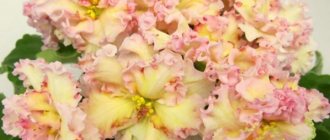LE-Fuchsia Ballerina
Discussion of Saintpaulia varieties by breeder Elena Lebetskaya.
Moderator: Floriana
Alla Matyusheva Messages: 1296 Registered: Aug 15, 2009, 12:59 pm Awards: 14 From: Russia, Syktyvkar
LE-Fuchsia Ballerina
#1
Message by Alla Matyusheva » November 28, 2011, 16:27
Saintpaulia LE-Fuchsia Ballerina. Breeder E. Lebetskaya Large semi-double and double stars of bright raspberry-fuchsia color, light foliage.
Very abundant flowering. 2010
First flowering.
Alla Matyusheva
Fialochka_23 Messages: 168 Registered: November 01, 2011, 17:50 Awards: 3 From: Odessa region, Yuzhny
Violet_23
Blueberry Messages: 1658 Registered: March 17, 2010, 00:31 Awards: 26 From: Moscow
Blueberry
Yalo Messages: 1622 Registered: 11 Feb 2011, 16:01 Awards: 12 From: Russia. Moscow
Re: LE-Fuchsia Ballerina
#5
Post by Yalo » 13 Feb 2012, 10:03
Hard worker variety. Easy to grow, it quickly gains leaf mass and tries to bloom at every opportunity.
Yalo
FGP Messages: 229 Registered: Oct 22, 2012, 10:00 AM Awards: 9 From: Ekaterinburg
Re: LE-Fuchsia Ballerina
#9
FGP message » 29 Oct 2012, 21:42
I love her for her rare hard work and desire to bloom in any conditions, for the caps and skullcaps of flowers, for the brightness of the fuchsia color. In a word, darling.
FGP
Floriana Deputy Administrator Messages: 14940 Registered: March 20, 2011, 15:36 Awards: 48 From: Ukraine
Floriana
MIKHAILOVNA Messages: 45 Registered: June 08, 2022, 05:44 Awards: 3 From: NOVOKUZNETSK
MIKHAILOVNA
Blue, blue and lilac indoor violets
Saintpaulia, or Usambara violet Apache Magic (J. Munk)
The flowers are very large, semi-double, rich dark purple-blue, with a strongly wavy edge. The foliage is variegated and ruffled: dark green with white and pink edges. Standard.
Saintpaulia Apache Magic (J. Munk)
Saintpaulia, or Usambara violet Rainbow's Quiet Riot (R. Wasmund)
The flowers are semi-double, blue with bright white streaks. The rosette is smooth with dark green leaves.
Saintpaulia Rainbow's Quiet Riot
Saintpaulia, or Usambara violet Charming eyes
The flowers are simple, white and blue. The leaves are variegated; with age, signs of variegation disappear. Standard.
Saintpaulia Charming eyes
Saintpaulia, or Uzambara violet LE-Moon Dreams (E. Lebetskaya)
Very large blue flowers with a wavy, corrugated edge and a thin white border.
Saintpaulia LE-Moon Dreams
Saintpaulia, or Uzambara violet variety Blue Fog (Blue Fog, K. Morev)
The flowers are very large, double, blue with light wavy edges. The leaves are light green, serrated. Standard. The socket is large.
Saintpaulia variety Blue Fog or Blue Fog
Saintpaulia, or Uzambara violet LE-Sea of Happiness (E. Lebetskaya)
The flowers are simple or semi-double, white-blue with a wavy edge. Standard.
Saintpaulia LE-Sea of Happiness
Saintpaulia, or Usambara violet Storm's Eye (LLG/P.Sorano)
Saintpaulia Eye of the Storm blooms with semi-double and double large flowers. Standard. The socket is quite large.
Saintpaulia Storm's Eye
Saintpaulia, or Usambara violet variety Bold Party Girl (sport)
The flowers are double, lilac-pink with a lilac eye and light pink edges.
Saintpaulia variety Bold Party Girl (sport)
Botanical description of the plant
Ballerina forms a dense rosette of elastic leaves from 20 cm to 40 cm in height. The leaf blade is dark green, oval in shape, with a wavy edge. The young plant blooms about a year after planting. In spring, long flower stalks with numerous buds appear.
This variety has virtually no breaks in flowering: as soon as one peduncle fades, the next one appears in new leaves. In this case, the flowers last for about 2 months. The exception is winter, a relative period of rest. Large terry baskets up to 7 cm in diameter are painted white. The petals are arranged in several rows, the middle of the flower is yellow.
Violet RS-Ballerina
Huge (up to 7cm) double wavy snow-white flowers with a finely corrugated greenish edge. Strong peduncles, abundant flowering, medium green arched foliage.
Read more
Orders are now accepted
See similar products that you can order right now
RUR 695.
74 orders
Pot size in inches: 2.5″ See additional photo for photo of supplied plantPlants do not arrive flowering...
914 rub.
56 orders
Pot size in inches: 2.5″ See additional photo for photo of supplied plantPlants do not arrive flowering...
1132 rub.
30 orders
Pot size in inches: 1.7″ See additional photo for photo of supplied plantPlants do not arrive flowering...
1132 rub.
23 orders
I RECOMMEND! THIS PHALAENOPSIS IS A NATURAL HYBRID OF 2 NATURAL ORCHIDS APHRODITE AND EQUESTRIX. GORGEOUS...
695 rub.
31 orders
Pot size in inches: 2.5″ See additional photo for photo of supplied plantPlants arrive not flowering
695 rub.
29 orders
This variety tends to bloom differently; one variety can have different flowers. Pot size...
914 rub.
20 orders
Pot size in inches: 2.5″ See additional photo for photo of supplied plantPlants do not arrive flowering...
695 rub.
23 orders
Pot size in inches: 2.5″ See additional photo for photo of supplied plantPlants do not arrive flowering...
695 rub.
24 orders
Pot size in inches: 2.5″ See additional photo for photo of supplied plantPlants do not arrive flowering...
914 rub.
22 orders
BEAUTIFUL VARIETY WITH WAVY EDGES Pot Size in inches: 2.5″Photo of plant supplied cm in to…
914 rub.
18 orders
MULTIFLOROUS LUXURY FLOWERING PHALAENOPSIS WITH DELICATE PINK FLOWERS AND A STRONG SCENT OF LILY OF THE LILY. R…
695 rub.
20 orders
Pot size in inches: 2.5″ See additional photo for photo of supplied plantPlants arrive not flowering
914 rub.
14 orders
Pot size in inches: 1.7″ See additional photo for photo of supplied plantPlants arrive not flowering
695 rub.
15 orders
Pot size in inches: 1.7″ See additional photo for photo of supplied plantPlants arrive not flowering
1132 rub.
10 orders
Pot size in inches: 2.5″ See additional photo for photo of supplied plantPlants do not arrive flowering...
914 rub.
11 orders
Pot size in inches: 2.5″ See additional photo for photo of supplied plantPlants do not arrive flowering...
1132 rub.
8 orders
Pot size in inches: 2.5″ See additional photo for photo of supplied plantPlants do not arrive flowering...
914 rub.
11 orders
Pot size in inches: 2.5″ See additional photo for photo of supplied plantPlants do not arrive flowering...
914 rub.
10 orders
Pot size in inches: 1.7″ See additional photo for photo of supplied plantPlants arrive not flowering
1132 rub.
9 orders
Pot size in inches: 2.5″ See additional photo for photo of supplied plantPlants arrive not flowering
Violet RS-Ballerina
RUB 150.80
Buyer Protection
Huge (up to 7cm) double wavy snow-white flowers with a finely corrugated greenish edge. Strong peduncles, abundant flowering, medium green arched foliage.
Violet Ballerina: description of the variety and characteristics
Violet Ballerina: photo of the variety
The violet variety RS Ballerina belongs to Saintpaulia with all its characteristic features. Violet Ballerina belongs to the Gesneriev family and is a herbaceous plant with bright fluffy flowers. It is called violet secondarily, this is its genus.
The violet variety RS Ballerina was developed by breeder Svetlana Repkina, and it was thanks to her efforts that real beauty was achieved.
This amazing plant still captivates both professionals and beginners in the field of floriculture. With the help of its aesthetic qualities, the violet Ballerina continues to delight and receives awards at various flower competitions.
This variety of violet Ballerina should not be confused with the violet fuchsia Ballerina (2nd name violet LE Ballerina. The violet fuchsia ballerina is very similar to the violet RS Ballerina, there is some external similarity. The violet fuchsia ballerina has not white flowers, but a bright purple color, each petal has a white edge.
The violet variety RS Ballerina has flowers reminiscent of snow-white and lush ballet tutus. During flowering, the plant is covered with voluminous buds, which soon turn into beautiful double flowers. The size of the basket can reach 7 cm. The petals are arranged in several rows, so the flowers look voluminous and expressive, and the yellow core only emphasizes this expressiveness.
If you properly care for and create the right conditions for the Ballerina violet, then you will be guaranteed constant flowering, and breaks between flowering will be rare and short-lived.
The withering of old flowers on the bush is immediately replaced by young flower stalks. If the Ballerina develops correctly, then the amazingly beautiful flowers do not fade for about 60 days.
Only in winter does the Ballerina violet not bloom very profusely, since the plant’s growth and development processes are slowed down. If we talk about the first flowering, then Ballerina will delight its owner with them a year after planting.
Typically, all Saintpaulias have approximately similar dark green leaf blades, the surface of which is covered in small and soft fibers. As it develops, the Ballerina violet forms rosettes reaching a height of 20-40 cm. The leaves have an oval shape with wavy edges.
Choosing a landing site
Peony Ballerina can be bought in nurseries and garden stores. In order for the plant to take root and develop successfully, it is necessary to correctly select and prepare the planting site.
Ventilated sunny locations without strong drafts are suitable for peonies. Planting in shaded areas results in poor flowering. Avoid places near the walls of buildings, from which the plant gets overheated.
Trees that deplete moisture and nutrients should not be chosen as neighbors. Roots rot in lowlands and wetlands.
A few weeks before planting, dig a 50x70 cm hole, which is filled 2/3 with soil made from humus, earth, sand and peat. Add 0.4 kg of bone meal and 1 cup of superphosphate to the mixture.
How to grow?
Light and location
The variety "RS-Ballerina" feels great on the windowsill. This is the standard arrangement for indoor flowers. It is best to move the pot closer to the window so that the plant receives maximum sunlight. If you decide to place the container on a rack, place it in the first row. Be careful when placing the potted plant in a south-facing window. Make sure that direct rays do not touch it. If necessary, darken this area using curtains or white paper.
Important! The minimum daylight hours for the Ballerina violet should be at least 10 hours. During the cold season, it must be maintained with artificial lighting.
Humidity and temperature
The ideal temperature ranges from 20 to 22 degrees Celsius above zero. With sunset, this indicator can be lowered by 2-3 degrees. To prevent the plant from getting sick and to enjoy its rich color, protect it from sudden temperature changes and drafts. The optimal indoor air humidity varies from 50 to 60%. This value is difficult to maintain during the heating season, when batteries and heaters cause the air to become drier. To maintain comfortable conditions, place a small tray with moss or moistened expanded clay next to the plant.
Features of caring for violet ballerina
Ballerina violet prefers natural light, but you should not place the plant in areas directly exposed to sunlight, as this can lead to its withering. It is best to plant violets on a north window.
If the owner cannot place the violet ballerina in a given place, then it must be limited from exposure to rays using a thick curtain. The ideal option in this case would be tulle, which will limit exposure to sunlight and at the same time provide very good lighting to the violet.
Choosing a pot for violets:
- It is also quite an important point when growing this plant.
- In this case, it is best to choose plastic pots, in which the ballerina violet will grow and develop most beneficially.
- For a ballerina violet, the ideal option would be a pot whose diameter does not exceed 10 centimeters.
Ballerina violet is best planted in ordinary soil.
You can also use centipoly to plant this plant. The pot must be filled halfway with drainage. Caring for ballerina violets also requires maintaining proper watering.
- If there is insufficient watering, the violet will develop slowly or dry out altogether.
- At the same time, you should also not overdo it with watering, since excessive soil moisture can lead to rotting of the root system of the flower and its death.
- Watering must be done in this way: in a bowl of water you must place a pot with a violet, at the bottom of which there must be a hole. The violet will independently saturate its root system with water.
- You can add fertilizer to a bowl of water, which will ensure more productive flowering of this plant.
Ballerina violet requires regular fertilization. This action must be performed once every two weeks. Fertilizers are applied during the violet flowering period. Do not overdo it with the amount of fertilizer, otherwise it will negatively affect the growth and development of the flower.
Violets need to be replanted once a year.
This plant is planted in the same pots. When transplanting violets, you just need to replace the soil. Violet also requires regular spraying. To do this, it is best to use a spray bottle with water at room temperature. You can also wipe the violet leaves with a damp cloth, which will have a beneficial effect on the flowering of this plant. Hygienic cleaning of violets should be done in the bathroom. After cleaning the flower, it should dry in a shaded place. If the flower is placed in the sun, its rays will harm the violet.
Caring for violets requires regularly performing the following actions:
- Watering.
- Fertilizer application.
- Transfer.
- Providing a full light regime.
If you carry out all these steps in a timely manner, then the ballerina violet will become a real decoration of any room.
DIY ballerina template for a panel
In order to create a panel, you must first select a template. You can make it yourself, which is justified exclusively for people with excellent artistic skills. For everyone else, it is advisable to use a ready-made product, which will not be difficult to find.
As a rule, wall panels are made on a plain background, for which it is better to choose pastel colors. The silhouette of the ballerina itself should be either black or white. Then the picture looks most impressive.
To achieve a more festive look, you can use sparkles that adorn the dancer’s figure. Thus, you can get: a bright and memorable original panel that will never get boring over time.
In order not to make a mistake with proportions and choose the best composition, you can take advantage of master classes in which experienced craftsmen give advice to beginners. When doing the job for the first time, you can take into account their tips that will help you avoid common mistakes. Then, performing the work subsequent times, you can give free rein to your imagination, which allows you to somewhat refresh the picture and give it a touch of individuality.
Basic rules for caring for fuchsia during the growing season
The main measures for caring for fuchsia, after its acquisition, are considered:
- correct choice of location;
- compliance with temperature and humidity conditions;
- feeding
In the life of fuchsia, two periods :
- active growth: from spring to autumn;
- relative rest: winter.
Let's consider the rules for caring for a fuchsia flower during the period of active growth . At this time, the plant should be placed on a well-lit windowsill of an eastern or western window, but not in direct sunlight. It is better not to put fuchsia on southern windows, because... she is too likely to get sunburned.
If there is no bright place in the house for fuchsia, then it should be provided with additional artificial lighting , using, for example, fluorescent lamps. Otherwise, fuchsia blooms may not be seen.
This also applies when installing a flower on a northern windowsill with insufficient light.
The plant loves clean, often ventilated air . The presence of drafts is unacceptable. Rearrangements from place to place and rotations around its axis are not desirable for fuchsia. The air temperature during this period should be approximately +20+22 degrees.
higher ambient temperatures You can place fuchsia on a balcony, loggia, or open terrace in the summer. To prevent the sensitive root system of the plant from overheating in the heat, you need to transplant it into a wide ceramic pot.
Watering fuchsia during the growing season should be moderate: the soil should not become moldy or dry out. Water for irrigation should be used that is settled, soft, and at room temperature. In the hot season, the plant needs to create an additional humid microclimate.
Early in the morning or in the evening it is good to spray fuchsia with cool water. You can place a beautiful container with water and pebbles next to the flower, which will help create the desired microclimate around the flower.
The plant needs weekly feeding with fertilizers throughout the active period. After flowering has stopped, you can take a short break from using fertilizers. In the fall, from about September-October, fertilizing the flower is gradually stopped. As fertilizers, special fertilizers for house flowers are used with a high content of phosphorus and potassium, which are so necessary for the normal functioning of the flower.
With proper care, fuchsia will delight everyone with its long and lush flowering, from May to the end of November. A prerequisite for long-term flowering of a plant is the constant removal of faded flowers .
Throughout the growing season, the plant should be constantly pinched to form the desired shape. You need to be prepared for the fact that each pinching delays flowering for almost 2 months.
At home, fuchsia should be replanted annually . It is better to carry it out in March. The scheme for this is simple: first, drainage is placed in the pot, on which the prepared earthen mixture is placed, the plant with the earthen lump is carefully transferred and sprinkled with earth.
Care in indoor culture
Keeping the “Buckeye Ballerina” violet in indoor collections will not cause much trouble even for novice gardeners, provided they understand all the vital processes of the plant and carefully follow the standard set of care regimens, taking into account the nuances relating to variegated varieties.
Conditions of keeping in home collections
Saintpaulia, being a representative of tropical flora, belongs to the category of light-loving plants , which should be taken into account when choosing a permanent place for it indoors. It is best if it is a windowsill - here the violet will receive the greatest illumination by the rays of the daylight spectrum.
ATTENTION! The ideal option is a window sill on the western or eastern side of the room, since with a sufficiently long period of time with daylight, the flower will be protected from burns due to contact with direct rays of light that do not fall into these windows.
The absence of windows in the correct direction in the room forces flower growers to place their beauties on less suitable window sills.
In these cases, certain conditions must be met:
- on north-facing windows, plants will require additional lighting with fluorescent spectrum lamps;
- with south-facing windows, Saintpaulia will need shading during the summer heat.
Watering and fertilizing mode
Violet requires moderate watering with constant monitoring of the drying of the top layer of the substrate before each subsequent moistening - under standard microclimate conditions, twice a week is enough.
The irrigation regime provides for the use of three possible methods of adding water to the soil:
- wick;
- directly under the root;
- into the pallet.
Flower growers independently choose the most suitable method of watering for their conditions.
A properly equipped drainage system will protect Saintpaulia from rotting of the root system when water stagnates in the lower part of the flowerpot . This issue must be resolved in advance when planting violets.
When planting violets, be sure to use drainage.
The small volume of soil in the flowerpot, combined with the frequent flowering of the plant, leads to intensive consumption of nutrients, which can be replenished by applying the necessary fertilizers.
Feeding is done approximately once a month when the need for such a procedure is visually determined.
The rules for feeding variegated violets recommend clearly checking the percentage of chemical elements in the fertilizer with the life phase of the flower:
- during growth and active formation of a rosette, more nitrogen is required;
- Phosphorus and potassium are needed during the flowering phase
CAREFULLY! Overfeeding variegated Saintpaulia with nitrogen fertilizers is fraught with a change in the intensity of the light pattern or its complete disappearance due to an increase in the rate of formation of chlorophyll, which is responsible for the green color of the leaves.
Light level control
Violet prefers to be in natural daylight for a long time , but does not like direct rays of light: it requires light from a diffuse spectrum.
With active lighting intensity, Saintpaulia may lose the brightness of the fancy coloring of the corollas and lose the variegated pattern of the leaves.
This feature should be kept in mind with additional lighting - to preserve the decorative appearance of the outlet, the pot with the plant should not be placed too close to fluorescent lamps .
Insufficient lighting also leads to negative consequences - weakening or complete disappearance of the variegated mosaic of the rosette, lengthening of peduncles or shredding of flowers.
Uniform lighting plays an important role in the growth phase of the violet for the formation of an aligned rosette - it is necessary to systematically turn the flowerpot in one direction relative to the source of light rays.
Temperature compliance
Ideal conditions for variegated violets are considered to be temperature readings within +18 +20 ° C , although in winter it is permissible to lower the mercury column by another 2 - 3 degrees - this will not cause significant inconvenience to the plant.
Growing in a cool room has a beneficial effect on the decorative appearance of the light graphics of the rosette, as well as on how long the flowering corollas retain their fresh appearance.
High indoor temperatures cause the disappearance of the variegated color of leaves, a shift in the timing of flowering or a complete refusal of it, a change in the size of leaf blades and buds, and slower development.
The temperature of keeping variegated violets should be lower than that of conventional varieties.
At any period of a violet’s life, it is necessary to protect it from sudden temperature changes and drafts .
Humidity value
Saintpaulia loves slightly more humid air than that typical for ordinary apartments and other rooms with indoor collections contained there.
Therefore, for comfortable growth of violets, you should use a variety of industrial or home-made humidifiers .
Regular spraying of the air near flowerpots with plants will also have a beneficial effect.
Soil requirements
The substrate for comfortable growth of violets should be:
- easy;
- with good nutritional properties achieved by a balanced content of chemical elements of macro and microstructure;
- permeable;
- with optimal aeration.
crushed activated carbon and fine drainage materials to it . And be sure to use drainage systems.
The need for pruning and hygiene
The vital activity of violets does not require drastic interventions by the grower by pruning the bush.
For the plant, only hygienic and preventive cleanings , including the removal of diseased or dried leaf blades, faded corollas and children.
It is possible to target young leaves when thickening the center of the rosette for optimal violet growth.
Nuances of transplantation and rejuvenation
According to the rules existing among violet growers , young, fast-growing Saintpaulia bushes are transplanted once, less than twice a year.
age-appropriate violets , replanting them only when absolutely necessary.
Young violets are replanted at least once a year.
Any transplant is accompanied by a set of preliminary measures:
- choosing a pot according to the diametrical principle, preferably made of plastic;
- preparing fresh substrate, preferably store-bought;
- formation of drainage at the bottom of the flowerpot.
The choice of transplantation method always remains with the grower, but is determined by the purpose of the operation:
- if it is necessary to examine the violet roots, transplantation with a complete replacement of the substrate is used;
- in other cases, preference is given to more gentle transshipment.
After violets have been growing in an indoor collection for about five years, it is advisable to apply a rejuvenation procedure to update the decorative appearance of the rosette while preserving the varietal characteristics. For this purpose, the upper part of the bush with young leaf plates is carefully cut off and rooted according to the classical rules of growing violets.
Reproduction
There are several ways to propagate the plant at home. Let's look at the most common options.
Cuttings
To propagate using this method, a leaf is separated from the plant. He must be strong and healthy. It is best to choose a cutting from the middle row of the bush rosette. The following sequence should be followed:
- the leaf is carefully cut at an acute angle of 40–45 degrees;
- it is placed in a small container, where clean water and an activated carbon tablet are added;
- by covering the leaf with a cut plastic bottle, you can create a greenhouse effect that will promote growth;
- When roots appear, the sprout can be transplanted into the ground.
Children
You can grow violets from children if you use a rooted leaf. The work is carried out as follows:
- the bush is taken out of the pot;
- the baby is carefully separated from the root system of the mother plant; it must have at least 2 sheets;
- a separate sprout is transplanted into a container with soil, the height of which is no more than 6 centimeters.
Features of reproduction
Ballerina violet reproduces using leaves.
To do this you need:
- Take a leaf from a healthy violet. It is placed in a specially prepared pot.
- Before this, you need to hold the leaf in water, which will significantly speed up the reproduction process.
- To do this, you must use dark glass dishes.
- Medicine bottles are ideal in this case.
- Plain water is poured into the bottle, which must be diluted with distilled water.
- In order to prevent leaf rotting, activated carbon must be added to the water.
- The violet stalk is immersed in water no more than 1 centimeter. The cutting does not need to replace water, but it must be added regularly.
- Place the dishes with cuttings in a place protected from the sun. If the cutting rots, it must be cut at an angle.
- The cut site is filled with activated carbon. After a couple of weeks, roots will appear on the cutting, which will require planting the plant in the ground.
- To plant cuttings in the ground, you need to take containers with holes in the bottom (for example, plastic cups).
- One third of the container must be filled with a layer of drainage, and then covered with earth to the top.
- The cuttings are planted to a depth of one and a half centimeters. The violet leaf must be watered as the soil dries.
- The roots of this leaf will appear within 2-3 weeks after planting.
Reviews
- Tula region: winters and blooms normally, flowers look like clematis “Miss Bateman”;
- Kaluga region: it blooms very beautifully; in warm winters, meter-long lashes are preserved without shelter;
- Minsk region, Belarus: clematis took a long time to grow, began to bloom normally only in the fifth year;
- Leningrad region: it is not always possible to preserve last year’s stems, and “Ballerina” blooms very late on new ones;
- Vitebsk region, Belarus: the plant died;
- Moscow region: grows well, blooms every year, covers itself in the simplest way.
If you also grew or are growing clematis "Balerina", please leave your feedback in the comments to the article.
Possible diseases and pests
To prevent the plant from dying from disease or attacks from dangerous insects, preventive measures are needed. Before transplanting, it is recommended to heat the earthen mixture in an oven or treat it with a light solution of manganese. You also need to carefully examine the plant for symptoms and use medicinal drugs at the first signal.
It is worth paying attention to the most common problems.
Root rot
This disease affects the root system of the plant. The violet begins to lose its bright color and elasticity. The leaves gradually turn yellow and fall off. In this case, you need to remove the flower and inspect the roots. To cope with the problem, the flower is sprayed with a solution of “Fitosporin-M” (consistency – 1.5 grams per 1 liter of water). After treatment, the violet is transplanted into a clean pot with updated soil.
Shchitovka
This is a dangerous pest, which can be identified by the presence of a gray-brown shield on its back. If it is detected, move the violet to another place and treat it with the appropriate composition. The drug "Topsin-M" is excellent.
Thrips and aphids
These small sucking insects destroy the flower by feeding on its sap. To save the violet, use the Agravertin composition according to the instructions for use.
Gray rot
With this disease, the leaves become covered with a gray and fluffy coating. This disease can be overcome with the help of Topsin-M.
For a review of the “Ballerina” violet variety, see the following video.











